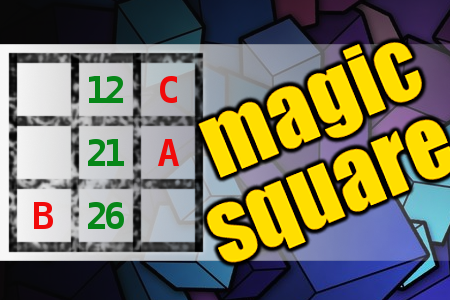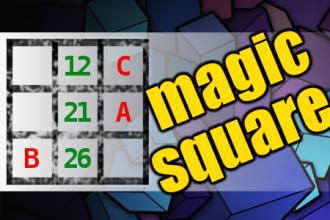MAGIC SQUARE: Calculate A+B*C
The aim is to place the some numbers from the list (2, 11, 12, 14, 18, 19, 21, 26, 27, 29, 64, 83) into the empty squares and squares marked with A, B an C. Sum of each row and column should be equal. All the numbers of the magic square must be different. Find values for A, B, and C. Solution is A+B*C.Correct answers: 3
#brainteasers #math #magicsquare

While taxiing at London's Gat...
While taxiing at London's Gatwick Airport, the crew of a U.S. Air flight departing for Ft. Lauderdale made a wrong turn and came nose to nose with a United 727. An irate female ground controller lashed out at the U.S. Air crew, screaming: "U.S. Air 2771, where the hell are you going?
I told you to turn right onto Charlie taxiway! You turned right on Delta! Stop right there. I know it's difficult for you to tell the difference between C and D, but get it right!"
Continuing her rage to the embarrassed crew, she was now shouting hysterically: "God! Now you've screwed everything up! It'll take forever to sort this out! You stay right there and don't move till I tell you to! You can expect progressive taxi instructions in about half an hour and I want you to go exactly where I tell you, when I tell you, and how I tell you! You got that, U.S. Air 2771?"
"Yes, ma'am," the humbled crew responded.
Naturally, the ground control communications frequency fell terribly silent after the verbal bashing of U.S. Air 2771. Nobody wanted to chance engaging the irate ground controller in her current state of mind. Tension in every cockpit around Gatwick was definitely running high. Just then an unknown pilot broke the silence and keyed his microphone, asking: "Wasn't I married to you once?"
I told you to turn right onto Charlie taxiway! You turned right on Delta! Stop right there. I know it's difficult for you to tell the difference between C and D, but get it right!"
Continuing her rage to the embarrassed crew, she was now shouting hysterically: "God! Now you've screwed everything up! It'll take forever to sort this out! You stay right there and don't move till I tell you to! You can expect progressive taxi instructions in about half an hour and I want you to go exactly where I tell you, when I tell you, and how I tell you! You got that, U.S. Air 2771?"
"Yes, ma'am," the humbled crew responded.
Naturally, the ground control communications frequency fell terribly silent after the verbal bashing of U.S. Air 2771. Nobody wanted to chance engaging the irate ground controller in her current state of mind. Tension in every cockpit around Gatwick was definitely running high. Just then an unknown pilot broke the silence and keyed his microphone, asking: "Wasn't I married to you once?"

